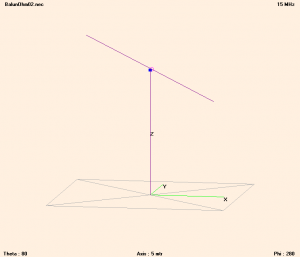One sees simplistic application of ohms law to antenna balun problems frequently in online forums, but is the technique valid?
Above is the model geometry of a sloping dipole in NEC. The vertical conductor models the common mode current path of a coaxial feed, the blue square near the top is a balun modelled as a load of 500+j500Ω. The red circle is the source exciting the model. This is a classic way of modelling a coax fed dipole.
The model solution shows the feed point voltage (ie the voltage that would appear between inner and outer conductor at the end of the coax) to be 95.6V for 100W RF power.
Back of the envelope Ohms law
The Ohms law solution so often used is that half of the feed point voltage is impressed across the balun common mode impedance and so current in the balun Ib=Vf/2/Zcm=95.6/2/(500+j500). Solving for the magnitude of Ib, we get 0.068A and the balun common mode loss would be calculated as I^2*R=0.068^2*500=2.31W.
NEC-4
NEC-4 calculates the magnitude of the current in the balun load as 0.103A, and the balun common mode loss would be calculated as I^2*R=0.103^2*500=5.31W.
The voltage impressed across the balun is| I|*|Z|=0.103*707=73V.
, quite a deal different than half the feed point voltage (95.6/2=47.8).
Error
In this example, the error in the Ohms law method is 34% in current, and 57% in power. Results will be different for different scenarios.
The voltage impressed across the balun is 73V, quite a deal different to the 47.8V basis of the back of the envelope Ohms law method.
The Ohms law method is sometimes described as a ‘worst case’ scenario, but in this case it underestimates current and power by a large amount… it is not ‘worst case’ at all… just plain wrong.
The Ohms law model is wrong / invalid because whilst one side of the balun common mode impedance is connected to one terminal of the source, there is no direct connection to tie the other side of the balun to a point midway between the source terminals and the assumption that the voltage at that point is midway between the source terminal voltages is baseless.
This is not to say that Ohms law doesn’t work, it is the inputs that are invalid and so the result is invalid.
It is a total failure of basic circuit analysis to think that this might work… yet it is done frequently by ‘experts’ and gullible readers soak it up.
If you see an ‘expert’ doing this, accept it as evidence that they really have no idea about baluns in antennas!
